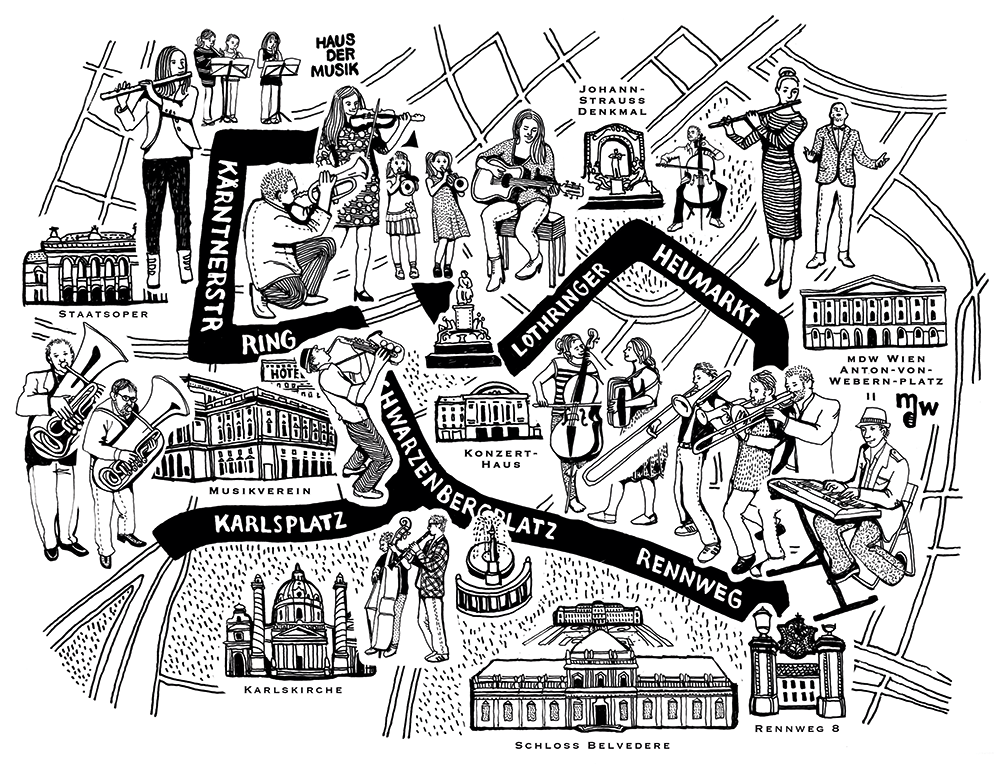“The mdw bicentennial is an excellent opportunity to do something big!” And a project that makes it possible to recognise and experience the (oft-hidden) ongoing and historical interaction of all the levels of training, institutions, and individuals so essential to bringing the arts and culture to life would be perfectly suited to the occasion. Starting from this idea, Wolfgang Aichinger, head of the Josef Hellmesberger Department of String Instruments, Guitar, and Harp in Music Education joined forces with Dietmar Flosdorf, who teaches the Musikvermittlung [Music Outreach] course at the same department, to initiate the project Klangketten [Chains of Sound] together with a team of colleagues.

This project will feature “sound islands”—hot spots distributed around Vienna’s Inner City that will host activities by mdw departments along with further invited institutions and individuals from the educational and cultural fields. The ideas behind these sound islands are myriad: from public rehearsals by a cello class where passers-by will be invited to comment on what they’re hearing to walk-in speech training offered by students from the Max Reinhardt Seminar, and from a waltz ensemble in front of the Stadtpark’s Johann Strauss statue to opportunities to try out various musical instruments. “The only limits are those imposed by one’s imagination,” emphasises Wolfgang Aichinger. The central focus here is on the significance of conveying and receiving art, and the overall concept dissolves the classic frontal dichotomy of performer and audience. It also does without the usual venues like concert halls or theatres, where the audience sees and hears the performers from a designated seating area. The point is much rather to convey the things that are taught and practiced daily at the mdw—doing so in the spontaneous atmosphere of public space and involving people whose presence is, at least in part, coincidental. This also presents the opportunity to reach those individuals who usually don’t go to the theatre, the opera, or concerts. The roles of performers and audience are broken up, with nobody limited to playing just one role, for the ability of passers-by to participate in public lessons or to comment on what they’ve heard entails that they themselves convey something, with the performers becoming listeners.
Since music outreach initiatives are receiving more and more attention these days, this project could be mistook for a purely educational initiative, revolving as it does around the mission of reaching society via art. But this is not the task of the educators alone; it is also very much one of the musicians and other performing artists in general. Klangketten, the project’s initiators stress, also seeks to make clear how arts outreach and the reception of art, in their interdependence, can meet on an equal footing.
One special attraction of this project is how it reaches out into the public space. Performances in unusual locations help take the focus off questions like, “Who plays better?” Instead, says Wolfgang Aichinger with conviction, the point is to get students thinking about the question, “How can one encounter people, convey one’s art to them, and get them enthusiastic about it?” In similar projects, he and Dietmar Flosdorf have had the experience that bringing artists together with people who seldom have the opportunity to participate in culture (or at least aren’t conscious of doing so) makes very strong impressions on students, moving them to value outreach more and also making them more conscious of their roles in society as artists.
Approaching the audience and inviting them to participate actively weakens the focus on elitism—without, however, negating the significance of excellence as a central aim. And both passers-by and participants can be enriched by the experience while coming to better understand just what excellence means: “In elite sports, it’s clear to everyone that excellence is chasing hundredths of seconds—but what it means to be accepted to an orchestra like the Vienna Philharmonic is something few people realise,” says Dietmar Flosdorf. Raising awareness of this and similar things is one of this project’s missions. Alongside outreach, the Chains of Sound will also be directed at the mdw and its community. Students, instructors, graduates, and non-teaching staff members from various institutes will be invited to form chains of their own with an eye to encouraging exchanges of ideas and collaborative arrangements that may not have arisen otherwise.
The project’s climax on the day of the actual event will be when the individual sound islands join to form one giant chain of sound as songs and sounds are passed from one link to the next, with the links consisting of the individual sound islands’ participants and passers-by. Thus, sound itself—as a connective element—will be not only heard but also rendered visible.
The project Klangketten is both an invitation and a gift to the mdw upon its bicentennial, and its connective character is intended to have lasting effects. What do Wolfgang Aichinger and Dietmar Flosdorf wish the mdw for its jubilee? “That the spirit of optimism and intense collaboration one experiences at the mdw be upheld,” says Wolfgang Aichinger. “And that 200 years from now, people looking back on the mdw’s history will do so with just as much admiration as we do now when we look back at its visionary beginnings, which paved the way for institutional music education for everyone on all levels of training,” adds Dietmar Flosdorf.
The Chains of Sound will thus also connect the historical with the present and the future, forming a bridge from the inside of the mdw—with its students, instructors, and other staff—to the outside world, to the passers-by and the sound islands’ various participants themselves.
- You’ll find full information on this project and how you can participate at: http://mdw200.at/en/klangketten/

